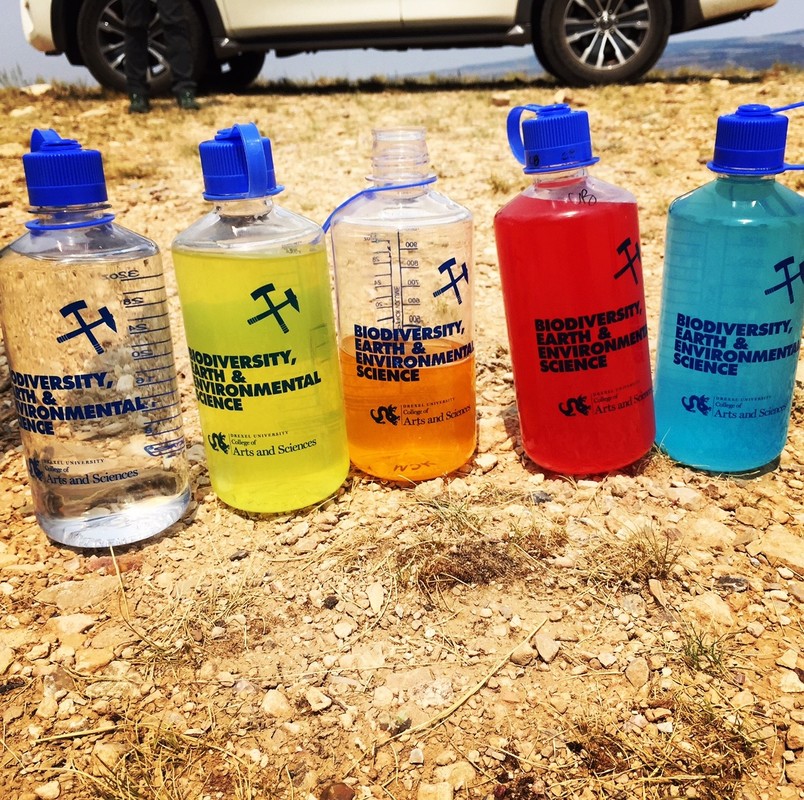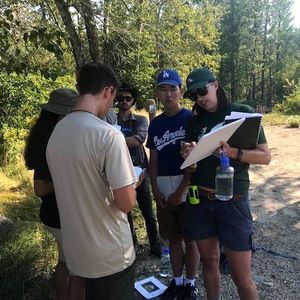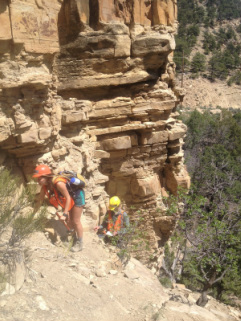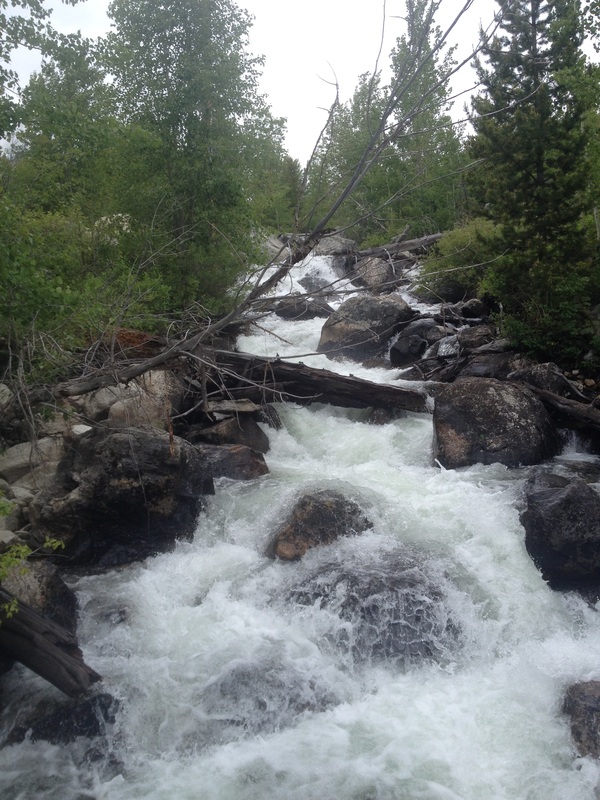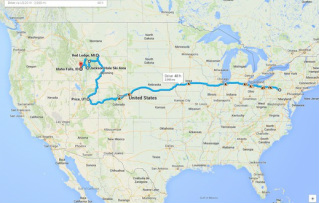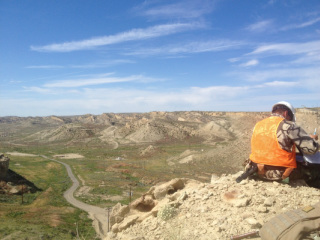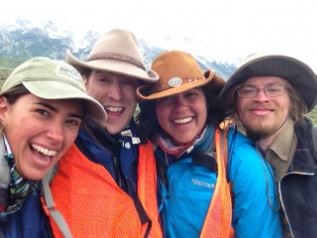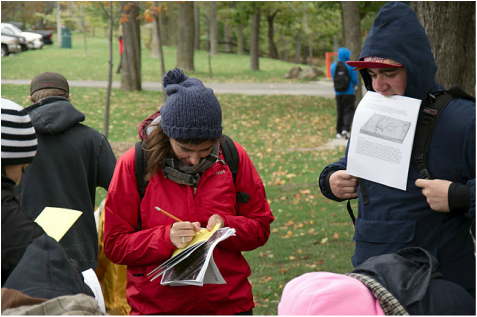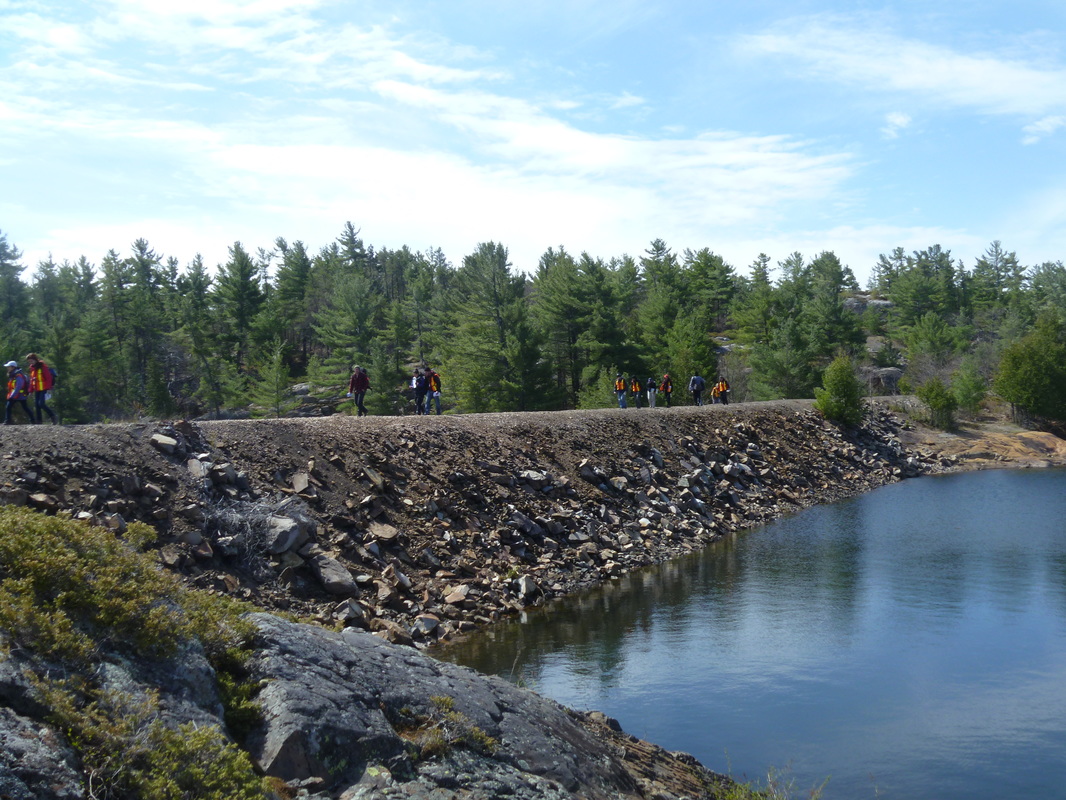Some of the students from GEOSC 472 A at the top of Specimen Ridge, Yellowstone National Park, WY
Teaching Experience
Drexel University
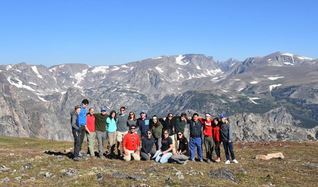 GeoDESLA 2018 students and staff at Yellowstone Pass
GeoDESLA 2018 students and staff at Yellowstone Pass
Camp Director, GeoDESLA (Geosciences module of Drexel's Environmental Science and Leadership Academy) - August 2018
Research shows that one of the most common reasons students get into the geosciences is because of positive field experience, ideally during high school The GeoDESLA field camp aims to provide students with just that. I lead the camp on it's inaugral year as students experienced digging for dinosaurs with the group at the Bighorn Basin Paleontological Institute, exploring the wonders of Yellowstone with Drexel Professor and volcanologist Loÿc Vanderkluysen, and www.bbpaleo.org/learnt about hydrology and glacial geomorphology with Senior Scientist and Assistant Professor Marie Kurz.
The students blogged about their experiences. Check out what we got up to here.
Research shows that one of the most common reasons students get into the geosciences is because of positive field experience, ideally during high school The GeoDESLA field camp aims to provide students with just that. I lead the camp on it's inaugral year as students experienced digging for dinosaurs with the group at the Bighorn Basin Paleontological Institute, exploring the wonders of Yellowstone with Drexel Professor and volcanologist Loÿc Vanderkluysen, and www.bbpaleo.org/learnt about hydrology and glacial geomorphology with Senior Scientist and Assistant Professor Marie Kurz.
The students blogged about their experiences. Check out what we got up to here.
Penn State University
Graduate Writing Tutor, College of Earth and Mineral Sciences - 2015 - 2017
Scientific writing is not easy, but it is crucial, regardless of the field students want to get in to after they finish their degrees. I worked with students in both group and individual settings to help them develop techniques to improve their science writing. The students came from a wide range of backgrounds across the college and I enjoyed working with them to develop techniques to edit and improve their own work.
As part of this role, I organised a yearly graduate student panel where undergraduate students could ask a panel of graduate students from the college questions about graduate school, internships, or industry possibilities. I also helped to run an undergraduate poster competition and arrange a diversity workshop.
Scientific writing is not easy, but it is crucial, regardless of the field students want to get in to after they finish their degrees. I worked with students in both group and individual settings to help them develop techniques to improve their science writing. The students came from a wide range of backgrounds across the college and I enjoyed working with them to develop techniques to edit and improve their own work.
As part of this role, I organised a yearly graduate student panel where undergraduate students could ask a panel of graduate students from the college questions about graduate school, internships, or industry possibilities. I also helped to run an undergraduate poster competition and arrange a diversity workshop.
|
Teaching Assistant - Field Camp (GEOSC 472 A) - Summer, 2014
Field work is an extremely important part in a geologist's education. This is the time that you can apply what you have learnt from text books to what you are seeing in the field. Penn State's field course is based out west and so we road-tripped from Pennsylvania, across the country to Utah, Wyoming, Montana, and Idaho. The course was split into three exercises:
Teaching in the field is completely different to teaching in the classroom. Students can find fieldwork overwhelming at first, I tried to instil confidence into the students by asking them questions to open up a discussion about what they were seeing. Often once a couple of links are made between what they know and what they are confused about (the rocks in the field), the students feel more confident to tackle the fieldwork alone. |
Image caption - clockwise from top: Our route for our trip out west; An overview of Elk Basin, Wyoming; Me and my fellow TA's Max Christie, Nooreen Meghani, and David Oakley; A river in the Grand Tetons National Park; Students studying rocks in the Book Cliffs, Utah.
Teaching Assistant - Earth in the Future (EARTH 103) - Fall 2013, Spring 2014, Fall 2015
This is a course designed to introduce non-scientists to the science behind climate change. This course is taught in two ways: 1) fully online; 2) in a blended format. This course is being developed as part of a broader scheme of courses designed to integrate geosciences and sustainability at the general education level. See the Integrate site for more details. http://serc.carleton.edu/integrate/index.html
My role was to help translate the labs from written format into the online format. We used the Angel Learning Management Suite as this is what is in place at Penn State. Questions were asked as an assortment of multiple choice, fill in blanks, answer boxes for calculations or graph readings, and true or false questions. Initially, there was some push back from students as they were used to the standard multiple choice questions, however, I think that the mixture of questions was a benefit overall. I particularly liked using the boxes for numerical answers as it is much closer to what a student in a traditional classroom would experience.
Although teaching online can be tough, TA-ing this class made me realise how important it is. These online courses are getting out to students from all round the world from new mums in the US to military posted across the globe!
Course Instructor - The Geology of the National Parks (GEOSC 010) - May 2013 - August 2013
This is an introductory level geology course which is taught online. The material for the course, developed by Dr. Richard Alley and Dr. Sridhar Anandakrishnan over the past 10 years, aims to teach students about geological processes by discussing them in the setting of the National Parks of America. My role was as the course instructor but, because the material had already been created, I spent most of my time communicating with the 250 students taking the class, opening and closing assignments and grading some of the extra credit assignments. The major teaching challenge was that this was the first course I had taught online. Communication occurred in a different manner than in the classroom which had its pro's and con's. On the positive side, because you were responding to students via e-mail, there was much more time to formulate a clear response and you could even find resources which helped explain certain concepts to students such as youtube clips. However, I found it difficult to create the same atmosphere as I do in a standard classroom. I like students to feel like they can ask questions whenever they are unsure of something but I found that some students feel like they are wasting your time if they e-mail you. I tried to get around this by sending out weekly e-mails about the material and stating that questions were welcomed. I also made sure to respond to all the e-mails I received in a positive manner so that students would feel like they could e-mail me again.
Teaching Assistant – Physical Geology (GEOSC 001) – January 2013 - April 2013
This is an introductory level geology course taken by both majors and non-majors. In this course students learnt about all types of geology from mineral identification to major natural hazards; from igneous rock formation to the results of iceberg formation. I taught two, two hour lab sections a week, graded the weekly lab reports and designed two lab exams. This course had two major teaching challenges, firstly there was a lot of new material and vocab for the students to get to grips with. I tackled this by explaining new terms, using them in context and thinking of catchy ways for students to remember this (see Ideas and Innovations section). I also encouraged students to ask me to redefine terms they had forgotten which, according to the mid-term reviews, they felt comfortable doing. Secondly, not all students were geology majors. This means that they were not necessarily interested in the material when they walked in the door. The way I tackled this was to find out what they were majoring in and then I made links between what we were learning and what they were interested in. For example, a lot of my students were petroleum and natural gas engineers. When we were doing the porosity and permeability lab, I asked them questions about oil reservoirs, cap rocks and source rocks. By knowing the application of what they were learning, I found that students seemed to engage in a more positive manner.
Teaching Assistant – Geology of Oil and Gas (GEOSC 454) – January 2013 - April 2013
This is an upper level class which tackles the properties, origin, migration and occurrence of oil and gas. This course is taken by two main groups of majors: 1) Geology majors; 2) Petroleum and Natural Gas Engineers. I co-taught two, two hour lab sessions a week, wrote exam questions, held office hours and graded lab assignments. One difficulty teaching this course was the wide range of geology background each student had had. The geology majors were comfortable with a lot of the large scale geology, such as how folds and faults operated but tended to be less familiar with the technical data collection procedures, such as wireline logging. The PNG majors were comfortable with how the data was collected but struggled with applying this back to the geology. I tackled this in two ways. Firstly, I made it a priority to find out the level of background knowledge the students had by talking to them in labs. This gave me an idea of the platform of knowledge on which we were building. Secondly, I encouraged students to attend office hours where I was happy to explain the background concepts at a slower pace where this was needed. As the term progressed, it became clear that the students who took the extra time to come and ask questions on the material that they were struggling with faired much better in the labs.
Teaching Assistant – The Sea Around Us (GEOSC 040P) – September 2012 - December 2012
This is a lab based course which serves as a general education credit for arts students. The course addresses the role of the world's oceans starting with the shape of the sea floor and moving through discussions about ocean circulation, tsunamis, coasts, erosion and finally how anthropogenic changes will affect the oceanic ecosystem as we understand it today. I taught three, 2 hour lab sessions to classes of between 25 and 30 students. The labs consisted of a 15 minute introduction after which the students split into groups to complete the lab exercise. All students had to hand in a lab each week and there were three, non-cumulative tests throughout the term. The part I found most difficult was trying to establish the level of background knowledge that the students had before building on that. I felt that this improved as the term went on as I got to know the students better and they became more comfortable asking questions.
This is a course designed to introduce non-scientists to the science behind climate change. This course is taught in two ways: 1) fully online; 2) in a blended format. This course is being developed as part of a broader scheme of courses designed to integrate geosciences and sustainability at the general education level. See the Integrate site for more details. http://serc.carleton.edu/integrate/index.html
My role was to help translate the labs from written format into the online format. We used the Angel Learning Management Suite as this is what is in place at Penn State. Questions were asked as an assortment of multiple choice, fill in blanks, answer boxes for calculations or graph readings, and true or false questions. Initially, there was some push back from students as they were used to the standard multiple choice questions, however, I think that the mixture of questions was a benefit overall. I particularly liked using the boxes for numerical answers as it is much closer to what a student in a traditional classroom would experience.
Although teaching online can be tough, TA-ing this class made me realise how important it is. These online courses are getting out to students from all round the world from new mums in the US to military posted across the globe!
Course Instructor - The Geology of the National Parks (GEOSC 010) - May 2013 - August 2013
This is an introductory level geology course which is taught online. The material for the course, developed by Dr. Richard Alley and Dr. Sridhar Anandakrishnan over the past 10 years, aims to teach students about geological processes by discussing them in the setting of the National Parks of America. My role was as the course instructor but, because the material had already been created, I spent most of my time communicating with the 250 students taking the class, opening and closing assignments and grading some of the extra credit assignments. The major teaching challenge was that this was the first course I had taught online. Communication occurred in a different manner than in the classroom which had its pro's and con's. On the positive side, because you were responding to students via e-mail, there was much more time to formulate a clear response and you could even find resources which helped explain certain concepts to students such as youtube clips. However, I found it difficult to create the same atmosphere as I do in a standard classroom. I like students to feel like they can ask questions whenever they are unsure of something but I found that some students feel like they are wasting your time if they e-mail you. I tried to get around this by sending out weekly e-mails about the material and stating that questions were welcomed. I also made sure to respond to all the e-mails I received in a positive manner so that students would feel like they could e-mail me again.
Teaching Assistant – Physical Geology (GEOSC 001) – January 2013 - April 2013
This is an introductory level geology course taken by both majors and non-majors. In this course students learnt about all types of geology from mineral identification to major natural hazards; from igneous rock formation to the results of iceberg formation. I taught two, two hour lab sections a week, graded the weekly lab reports and designed two lab exams. This course had two major teaching challenges, firstly there was a lot of new material and vocab for the students to get to grips with. I tackled this by explaining new terms, using them in context and thinking of catchy ways for students to remember this (see Ideas and Innovations section). I also encouraged students to ask me to redefine terms they had forgotten which, according to the mid-term reviews, they felt comfortable doing. Secondly, not all students were geology majors. This means that they were not necessarily interested in the material when they walked in the door. The way I tackled this was to find out what they were majoring in and then I made links between what we were learning and what they were interested in. For example, a lot of my students were petroleum and natural gas engineers. When we were doing the porosity and permeability lab, I asked them questions about oil reservoirs, cap rocks and source rocks. By knowing the application of what they were learning, I found that students seemed to engage in a more positive manner.
Teaching Assistant – Geology of Oil and Gas (GEOSC 454) – January 2013 - April 2013
This is an upper level class which tackles the properties, origin, migration and occurrence of oil and gas. This course is taken by two main groups of majors: 1) Geology majors; 2) Petroleum and Natural Gas Engineers. I co-taught two, two hour lab sessions a week, wrote exam questions, held office hours and graded lab assignments. One difficulty teaching this course was the wide range of geology background each student had had. The geology majors were comfortable with a lot of the large scale geology, such as how folds and faults operated but tended to be less familiar with the technical data collection procedures, such as wireline logging. The PNG majors were comfortable with how the data was collected but struggled with applying this back to the geology. I tackled this in two ways. Firstly, I made it a priority to find out the level of background knowledge the students had by talking to them in labs. This gave me an idea of the platform of knowledge on which we were building. Secondly, I encouraged students to attend office hours where I was happy to explain the background concepts at a slower pace where this was needed. As the term progressed, it became clear that the students who took the extra time to come and ask questions on the material that they were struggling with faired much better in the labs.
Teaching Assistant – The Sea Around Us (GEOSC 040P) – September 2012 - December 2012
This is a lab based course which serves as a general education credit for arts students. The course addresses the role of the world's oceans starting with the shape of the sea floor and moving through discussions about ocean circulation, tsunamis, coasts, erosion and finally how anthropogenic changes will affect the oceanic ecosystem as we understand it today. I taught three, 2 hour lab sessions to classes of between 25 and 30 students. The labs consisted of a 15 minute introduction after which the students split into groups to complete the lab exercise. All students had to hand in a lab each week and there were three, non-cumulative tests throughout the term. The part I found most difficult was trying to establish the level of background knowledge that the students had before building on that. I felt that this improved as the term went on as I got to know the students better and they became more comfortable asking questions.
University of Toronto
Teaching Assistant – Whitefish Falls Field Camp (GLG340) – May 2012
This is a field course for geology majors where students learn how to take field notes and construct a geological map. The course is typically taken at either the end of second year or the end of third year which means that the group of 35 students had a range of levels of background knowledge. The first 5 days of the course were used to introduce students to the dominant lithologies in the area and teach them field skills such as how to keep a geological field book and how to measure dip and strike. For the second 5 days, students were given a 1 km x 1 km field section to map. These map sections overlapped and we walked around the field section mapping with several different groups for a couple of hours each day. I was one of three TA's on the trip and worked alongside two course instructors for ~ 10 hours a day. The difficult part about TA-ing this course was knowing where to send groups to find the best outcrops of a contact. Although this got better as the week went on, I think that this will improve with field experience.
This is a field course for geology majors where students learn how to take field notes and construct a geological map. The course is typically taken at either the end of second year or the end of third year which means that the group of 35 students had a range of levels of background knowledge. The first 5 days of the course were used to introduce students to the dominant lithologies in the area and teach them field skills such as how to keep a geological field book and how to measure dip and strike. For the second 5 days, students were given a 1 km x 1 km field section to map. These map sections overlapped and we walked around the field section mapping with several different groups for a couple of hours each day. I was one of three TA's on the trip and worked alongside two course instructors for ~ 10 hours a day. The difficult part about TA-ing this course was knowing where to send groups to find the best outcrops of a contact. Although this got better as the week went on, I think that this will improve with field experience.
Left: Teaching an intro geology course near Niagara Falls, ON. Right: Students in the field at Whitefish Falls, ON.
Teaching Assistant - Structural Geology - Spring 2012
Teaching structural geology is difficult and rewarding at the same time. For most students, it is the first time they are forced to think and do calculations for 3D problems. Structural geology is also not an exact science, you have some data and then there are often more than one way to interpret this data. Teaching this class taught me that different students learn in different ways. Sometimes I thought that I had found the perfect analogy for a problem, only to find that this didn't help the next group of students. Teachers constantly have to think of innovative ways to explain complex concepts to students. Once they understand the concept, they will be much better equipped to tackle more complex problems.
Teaching structural geology is difficult and rewarding at the same time. For most students, it is the first time they are forced to think and do calculations for 3D problems. Structural geology is also not an exact science, you have some data and then there are often more than one way to interpret this data. Teaching this class taught me that different students learn in different ways. Sometimes I thought that I had found the perfect analogy for a problem, only to find that this didn't help the next group of students. Teachers constantly have to think of innovative ways to explain complex concepts to students. Once they understand the concept, they will be much better equipped to tackle more complex problems.
